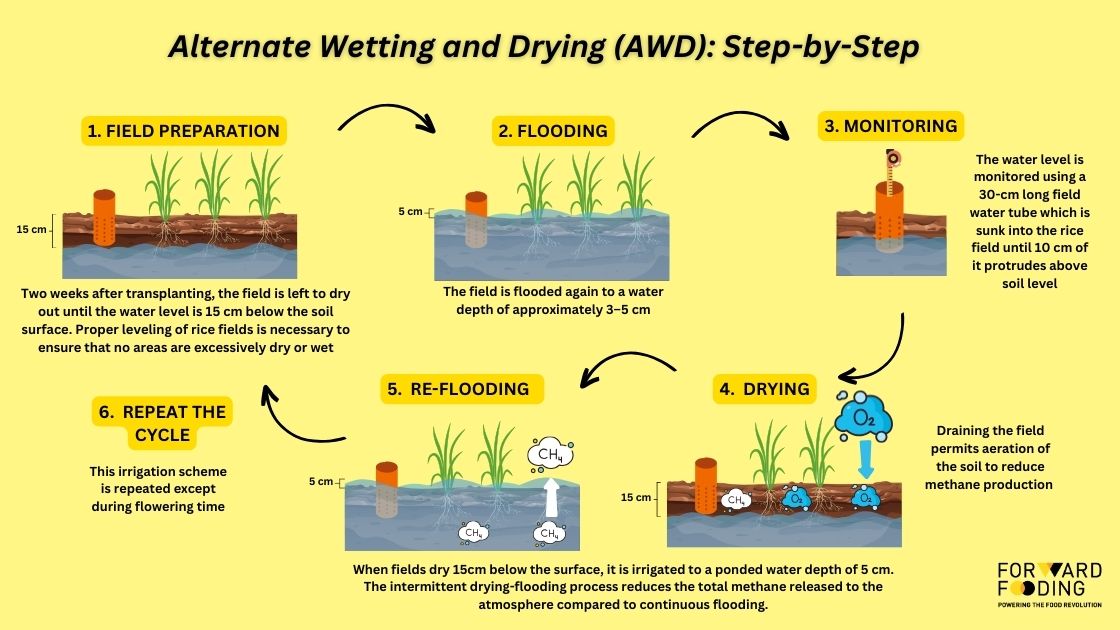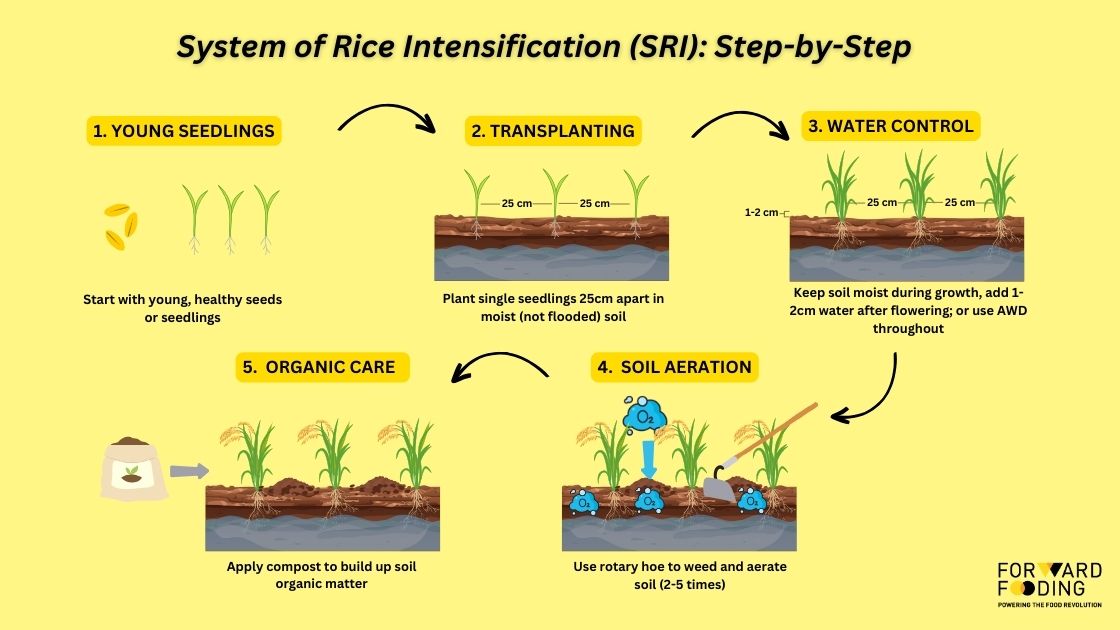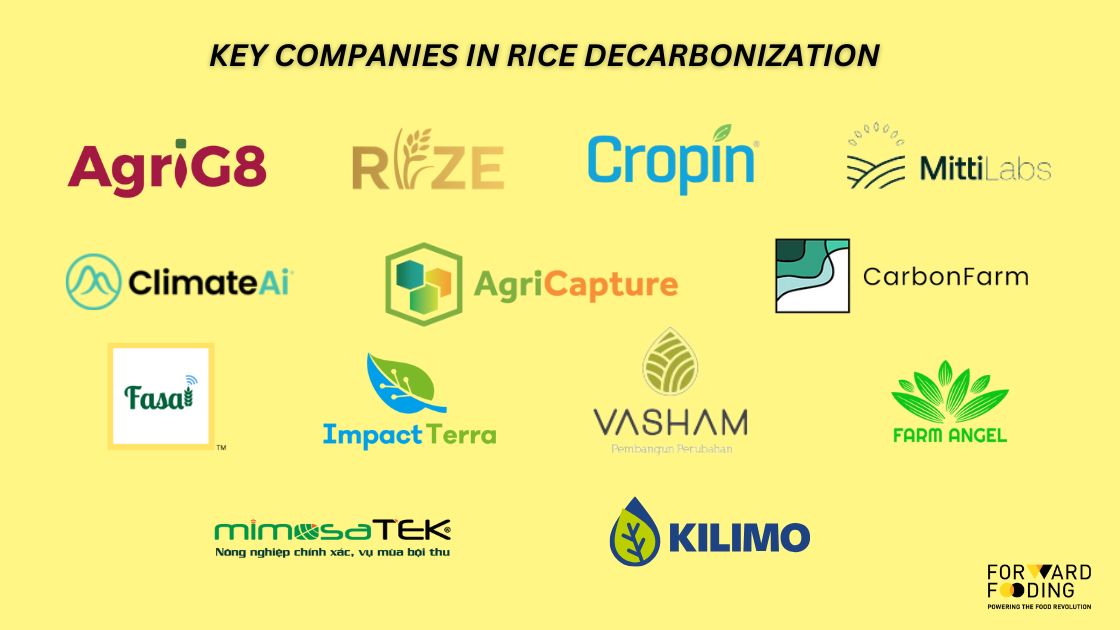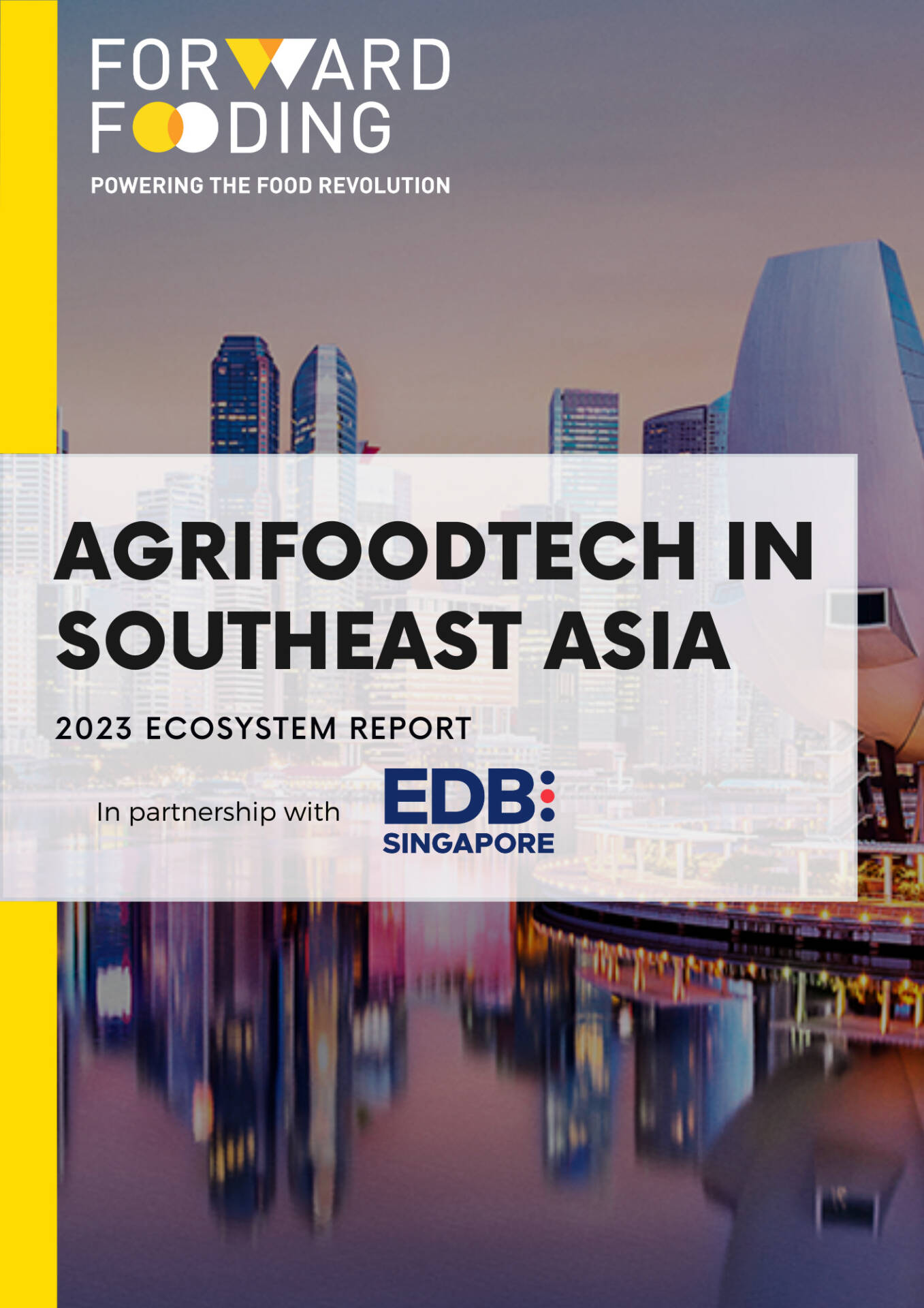FORWARD FOODING
THE BLOG
Rice Decarbonization: Reducing the World’s Most Essential Grain’s Carbon Footprint

Rice is not just a staple food that feeds over half of the world’s population. It’s also a contributor to climate change. While the world focuses on obvious emission sources like transportation and energy, rice cultivation quietly generates global greenhouse gas emissions equivalent to the entire aviation industry. But the agrifood system is waking up from this reality and rice decarbonization innovators are finding ways to lower rice’s GHG emissions.
Rice stands as a cornerstone of global food security, with its production projected to grow significantly to 565.6 million tonnes by 2025. This creates a challenging paradox: rice cultivation is both a contributor to climate change and vulnerable to its effects. The crop’s production generates multiple greenhouse gases including carbon dioxide (CO2), carbon monoxide (CO), methane (CH4), and nitrous oxide (N2O). Yet climate change itself threatens future rice yields, potentially creating a gap between production capacity and growing global demand.
The Rice Emissions Challenge
Flooded rice paddies might look peaceful, but underneath lies a complex environmental challenge. When fields are flooded, bacteria in the soil produce nitrous oxide and agricultural methane (accounting for 11% and 22%, respectively). These two GHGs are more potent and have higher Global Warming Potential (GWP) than that of CO2 for a 100-year timescale. Methane is about 30 times more powerful at trapping heat than carbon dioxide. Even worse, nitrous oxide is 273 times more potent than carbon dioxide at warming our planet. These effects last for at least a century.
Recent studies show that rice farming alone could be responsible for 19% of agriculture’s contribution to global warming by 2100. That’s nearly four times more than all other food crops combined, which only account for about 5%.
Not surprisingly, the major contributors to the atmospheric CO2 load of global rice production and consumption are the world’s rice bowls: Southeast, South, and East Asia. While these regions’ rice production accounts for a significant share of emissions (35%, 34%, and 18%, respectively), they’re also home to cultures and communities that feed billions.
The path forward isn’t stopping to produce or changing the staple food. It’s about empowering these traditional rice-growing regions with new tools and techniques to make rice production more sustainable.
Rice Decarbonization Technologies: A Step-by-Step Guide
1. Alternate Wetting and Drying (AWD)
Alternate Wetting and Drying (AWD) is a smart irrigation rhythm for rice fields. Instead of keeping paddies constantly flooded, farmers let them naturally dry out before flooding again, resulting in the same yields with less water and fewer emissions – a simple method of rice decarbonization.

- Field Preparation – Two weeks post-transplant, drain the field to 15cm below the soil surface. Install a perforated water monitoring tube (30cm x 10-15cm) and ensure the field is level for even moisture.
- Initial Flooding – Flood the field to about 5 cm above the soil surface during crop establishment. Maintain flooding for 2-3 weeks after transplanting.
- Monitoring, Drying, and Re-flooding – Allow water to drop 15cm below the surface, monitored via a water tube. When water disappears, re-flood to 5cm depth to prevent methanogenesis.
- Repeat AWD Cycle – Repeat dry/flood cycles except during flowering. Stop this alternating process 2-3 weeks before harvest.
Key Benefits of AWD
- Climate Impact: Cuts methane emissions by 30-70% by preventing waterlogged conditions where methane-producing bacteria thrive
- Water Efficiency: Reduces water use by 25-70% while maintaining yields, saving precious water resources and pumping costs
- Soil Health: Improves soil aeration and microbial activity, leading to better nutrient cycling and stronger root systems
- Economic Returns: Lower production costs through reduced water pumping, plus potential carbon credit revenue
- Simple Implementation: Easy to adopt with existing infrastructure and flexible timing, making it accessible for most farmers
2. System of Rice Intensification (SRI)
System of Rice Intensification (SRI) is an innovative, resource-efficient farming method that changes how we grow rice. Instead of traditional flooding and dense planting, SRI uses less water, fewer seedlings, and organic methods to boost yields. From its Madagascar origins in the 1980s to Asia’s vast rice bowls today, SRI is adopted by smallholder farmers to feed billions.

Traditional rice growing often uses older seedlings, flooded fields, and dense planting. SRI flips this approach:
- Seedling Propagation – Use young seedlings (8-12 day old; never older than 15 days) and grow them in garden-like nursery beds (not flooded paddies)
- Transplanting – Plant single seedlings 25cm apart in a square pattern, 1-2cm deep in moist soil.
- Smart Water Management – Keep soil moist until flowering, then add 1-2cm flood. AWD can be used throughout growth.
- Active Soil Aeration – Weed 2-5 times with a rotary hoe before the canopy closes, which also aerates soil for improved root growth.
- Organic Enrichment – Apply compost to build up soil organic matter and support healthy soil microbes. Chemical fertilizers are not recommended.
Benefits of SRI:
- Less Methane: By avoiding continuous flooding, SRI prevents the anaerobic soil conditions that methane-producing bacteria need
- Improved Root Systems: Stronger roots developed under SRI can better process nutrients, reducing nitrous oxide emissions
- Lower Input Use: Less reliance on chemical fertilizers means fewer emissions from their production and application
Rice Decarbonization Startup Landscape

Disclaimer: This list of companies is not exhaustive and only features certain products for demoing purposes – the full list is available via the FoodTech Data Navigator.
- Rize (Singapore) – Uses IoT sensors for precise water management, a mobile app for farmers to track AWD implementation, and works with large rice buyers for sustainable sourcing.
- Farm Angel (Singapore) – Works with smallholder farmers on sustainable paddy growing, digitizing the entire process from seed to sale and connecting farmers with buyers. This not only reduces greenhouse gas emissions but also generates carbon credits.
- AgriG8 (Singapore) – Agri-fintech platform supporting sustainable rice farming; The company’s technology combines in-the-moment observation with in-depth behavioral analysis to offer MRV measurement, reporting, and verification capabilities, giving lenders active monitoring and predictive modeling for a profit.
- Cropin (India) – Digital transformation enabler of the global food systems, which has invented the first industry cloud for agriculture. Their digital platform supports SRI implementation and monitoring
- Mitti Labs (India) – Enabling sustainable rice farming by developing the most transparent & high-quality projects; Uses satellites and AI to reduce rice emissions while improving farmer livelihoods
- Fasal (India) – AI-powered precision agriculture platform that records growing conditions on farms and uses artificial intelligence and data science to make on-farm predictions. Aids AWD implementation through real-time soil moisture monitoring, automated irrigation scheduling, and mobile alerts for farmers.
- MimosaTEK (Vietnam) – Smart irrigation for rice, including automated irrigation control systems, soil moisture sensors, and mobile alerts for AWD timing
- Ricult (Thailand/Pakistan) – Digital tools for precision agriculture in rice farming and provides weather forecasts, satellite data, and expert advice to improve productivity and profitability for farmers.
- Impact Terra (Myanmar) – Mobile app supporting SRI adoption. The platform provides advice, alerts, a chat, product and shop profiles, financing options, and other content to farmers while enabling service providers and knowledge institutes to connect directly to these farmers.
- Vasham (Indonesia) – Connects and simplifies the value chain, creating synergies and efficiencies that in return, empower producers and customers alike; Supports smallholder farmers in implementing SRI
- CROWDE (Indonesia) – Financing sustainable agriculture: Provides funding for SRI conversion, technical support through partners, and market access facilitation
- AgriCapture (USA) – Uses satellite monitoring to verify sustainable rice practices
- CarbonFarm (France) – Satellites and AI for monitoring decarbonization projects; They offer end-to-end support for farmers and agribusinesses, including project design, satellite-based monitoring, certification, and credit sales.
- Climate AI (USA) – Provides AI predictions for optimal SRI timing
- Kilimo (Argentina) – Water efficiency solutions for rice farming
Challenges to Navigate
Despite the promising solutions, several hurdles remain:
- Farmer Awareness and Education – Many farmers are not familiar with AWD and SRI practices, leading to resistance to change. It is never easy to convince farmers to adopt new practices. Education programs are crucial to inform farmers about the benefits and methods of these systems.
- Effects on Yield – AWD may slightly reduce rice yields due to moisture stress, but this reduction is less severe than direct drought stress. AWD’s proven success shows rice can thrive without continuous flooding, contrary to traditional beliefs.
- Economic Incentives – AWD’s cost-effectiveness varies by region: $20 per ton of CO2e saved in India versus over $45 in the Philippines and China. Despite the cost savings over time, creating economic incentives that work for smallholder farmers remains crucial to help them transition. Funding mechanisms that are fair to farmers and other financial opportunities such as financial incentives or subsidies, carbon credits may be necessary to encourage adoption
- Developing reliable MRV systems – Current MRV practices rely on manual documentation and self-declared results that lack transparency and traceability and are prone to fraud and misreporting.
- Scaling solutions across diverse growing regions – Each growing region has distinct climatic conditions, soil types, and water availability that affect the implementation of AWD and SRI practices. Tailoring these methods to fit local conditions is essential for their success but requires extensive research and local knowledge
Learn more about our Taxonomy in our Activity Spotlight for AgTech.
Forward Fooding is the world’s first collaborative platform for the Food & Beverage industry via FoodTech Data Intelligence and Corporate-Startup Collaboration – Learn more about our Consultancy and Scouting Services and our Startup Network.
Follow us
Sponsored Articles
9 July 2025
Forward Fooding celebrates the selection of 12 pioneering startups for the inaugural pladis Accelerator Programme. From water lily popcorn to sugar-converting enzymes, these innovations represent the future of snacking, addressing obesity, sustainability, and personalized nutrition through cutting-edge food technology.
21 March 2025
Tim Ingmire, VP of Global Innovation & Technology at pladis, discusses how the snacking giant is supporting early-stage startups in foodtech, health, and sustainability through their accelerator program. Learn about their focus on personalized nutrition, functional foods, and future ingredients to bring innovative, delicious products to consumers worldwide.
8 February 2024
Future Food-Tech returns to San Francisco on March 21-22 Over 1,700 food-tech leaders, from CPG brands, retailers, ingredient providers, [...]
1 February 2023
The 4th edition of FoodTech 500 is taking off and we are excited to partner with NEOM for the third consecutive year to support the best international AgriFoodTech entrepreneurs.
10 February 2022
One of the elements we enjoy the most here at Forward Fooding about working with AgriFoodTech startups is being [...]






